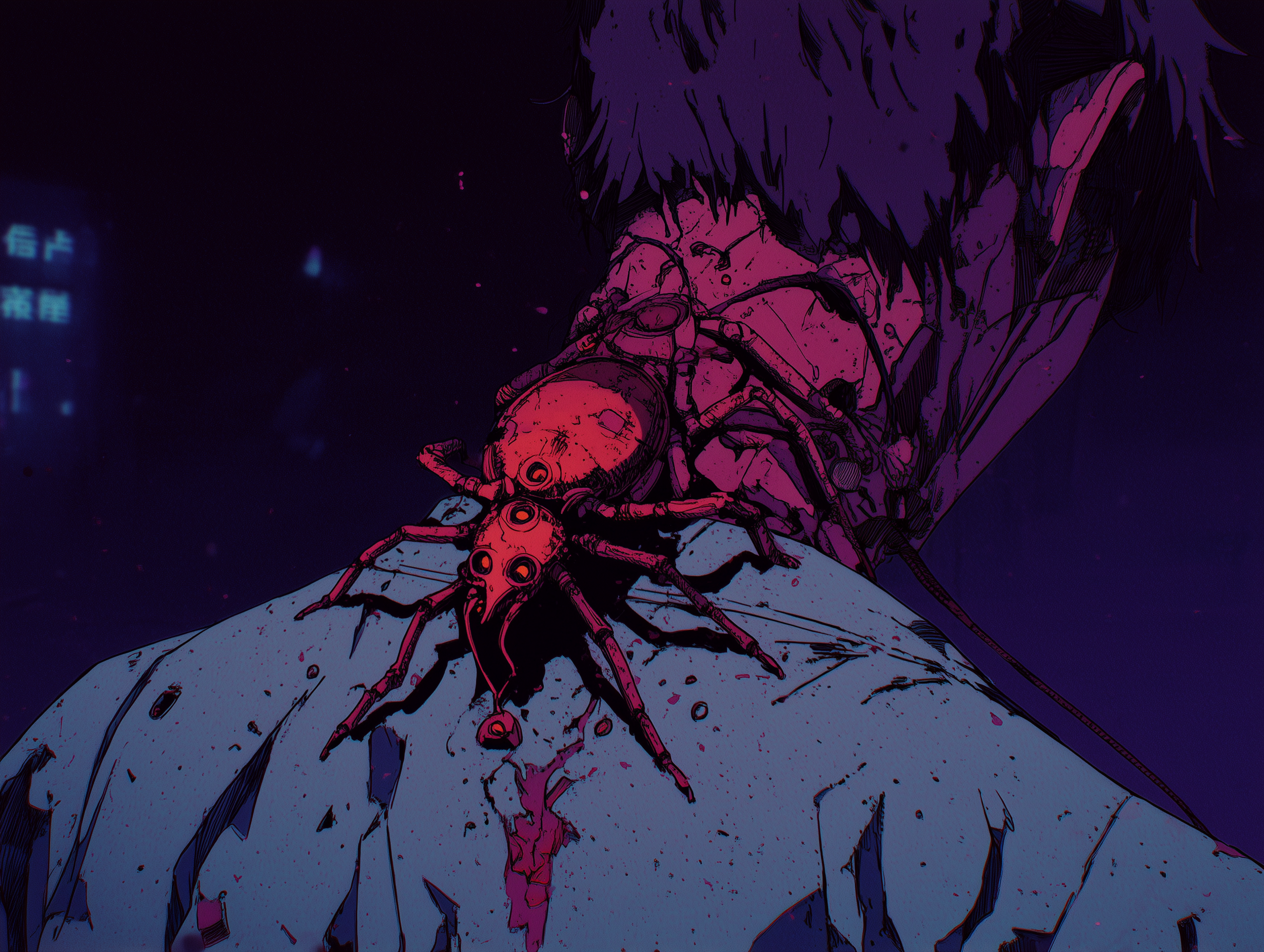WARNING! This is a graphic horror-themed article. Please be advised that some may find the descriptions in this article graphic or upsetting to read.
The Grasper Tick — Life Cycle
A Grasper Tick, a knot of chitinous, dull flesh, begins its grotesque quest by fastening itself to its future victim's ankle, then begins its slow climb upwards, an inching horror seeking clandestine purchase. Once it reaches the collar, it unfurls a glistening, tube-like proboscis from its own grotesque mass and plunges it into the soft flesh just above the host's collarbone. Through this invasive procedure, the Grasper Tick doesn't merely inject; it inseminates the host with its own living, twitching vasculature and neural tendrils. These self-replicating tendrils begin their insidious, creeping expansion throughout the host's interior. First, they seek anchor points in vital organs – the lungs and the heart – before winding their way to the spinal column, a central highway for their burgeoning network of nutrient stealers, from which they will bloom outward, consuming the brain stem, reaching into the remaining extremities.
If the parasite is permitted to complete its grotesque lifecycle, its systems will become inextricably woven with the hosts, rendering safe extraction a near impossibility. Inevitably, the Grasper Tick swells to an obscene, pulsating mass, engorged on the stolen life-force of its victim, its own nervous system eclipsing and ultimately suffocating the host's own awareness. Only then does the Grasper Tick detach from the nearly hollowed vessel it leaves behind, and scuttles away with an unnerving waddle, seeking out a proper nursery for its terrible propagation. These dark spawning grounds typically reek of dampness, moisture, and a cloying humidity – be it the rot of a bog, the decaying foliage of a forest floor, or the echoing, fetid stench of a city sewer. Any environment not too arid will ultimately suffice.
Once a prime breeding ground is secured, the Grasper Tick undergoes a final, abhorrent self-immolation, erupting into a viscous, nutrient-rich paste. Simultaneously, it exhales a fine, spore-like mist of eggs, which settles gently into the fertile, reeking slurry of its parents' remains. These nascent eggs, barely visible, are each encased in a sac of stolen sustenance, a perverse legacy of the symbiotic relationship. Once they consume this initial capsule of nutrients, they will ravenously devour the putrid, nutrient-rich paste that was, moments before, their progenitor. Despite the obscene bounty gifted to them by their dying parent, only a fraction of these eggs will ultimately writhe into their adulthood.
Death of the Carrier
Once the Grasper Tick has had its fill of its host's sustenance, it departs, leaving its victim to die a grisly, inevitable, and final agonizing death. Once the Grasper Tick swells, gorged, ready to bestow its temporary, unnatural boons, it will likely have grown several times its size and become a grotesque presence impossible to ignore. However, by this point, the two systems, tick and host, are irrevocably twisted together, and the victim will likely have to accept their approaching demise unless they are prepared to endure a drastic and experimental surgical invasion. While they are slowly dying, the victim will, of course, enjoy a brief, uncanny period – weeks or months, dictated by the parasite's appetite – bestowed with heightened senses and unnerving abilities. But once the tick is full and ready to depart, spreading its spore-like progeny into the night air, the carrier will collapse into a swift, irreversible decay.
The Grasper Tick, upon discarding the carrier, will not bother to reclaim its tendrils from the husk it is about to leave behind. Instead, it will absorb all possible nutrients into itself and simply shear away the rest, leaving the dying tendrils, still faintly pulsing, deep within the dying host. The process is a fleeting pain for the creature, though it already drifts towards its own conclusion, indifferent. The host is often seized by an immediate, violent shock, their form convulsing, shuddering, as if violently trying to reassert itself and reclaim territory suddenly bereft of the parasite's invasive presence. Without the parasite's influence, the body, now abandoned, engages in a chaotic, self-destructive war against an enemy that has vanished, only now registering its true, monstrous nature.
This finality typically descends within hours of the tick's withdrawal, the host's body enduring violent spasms, retching, and an unbearable agony as its own nervous system, betrayed, begins a frantic collapse. The victim eventually drifts into the dark quiet of unconsciousness, before surrendering to the final embrace of the beyond. Left a withered shell, the tendrils of its murderer still softly glowing through their skin.
Powers "Gifted" to the Carrier
While the powers gifted to the carrier of the Grasper Tick may initially seem like wondrous abilities, they are far from heroic. Those who have been interviewed during the process have spoken of these powers feeling like a perverse invasion of their body.
Like a foreign entity intruding upon them and rewriting the biological rules and perceptions of their own being. While these powers may present as extraordinary, they are in truth but a chilling side effect of a biological invasion and a terrifying glimpse into the workings of a creature that is working both itself and its victim into an ultimate and gruesome consumption of life.
Below are the various recorded "abilities" that have been granted to victims of the Grasper Tick. Much of the below was recorded by victims who agreed to be monitored and interviewed throughout the various stages of the tick's consumption of them.
Heightened Sensory Perception
Once the tick's neural tendrils reach the brain stem and extremities, the host experiences a vast expansion of their range of perception. This includes, but is not restricted to, enhanced regular sight, but could potentially include the host being able to see beyond the normal human spectrum. Seeing in infrared and/or ultraviolet and being able to perceive subtle environmental changes that they would never have been able to see prior. Though victims have reported that their sight often becomes overwhelmed by bright light, likely an effect of the tick's dislike of bright environments.
The host may also see their auditory and olfactory sense heightening, becoming able to hear acutely, sensing faint sounds from afar and even detecting subtle chemical signals from their environment or from other creatures. Though these senses often tend to be more of a curse than a blessing, as the victim is frequently overloaded by their awareness of smells and sounds they would not have otherwise perceived.
Unnatural Physical Augmentation
The tick also provides its host with a temporary transfer of biological energy, gifting the host some of its recycled energy in the hopes that it will prolong its meal.
These energy boosts can translate to temporary bursts of superhuman strength or speed, resilience to pain, or an extended capacity for physical exertion beyond normal human means. Some have even experienced an uncanny level of precision and dexterity, allowing for movements that exceed human capability.
This borrowed unnatural power may also grant the tick’s host a temporary, limited ability to recover from injury faster and a heightened resistance to environmental stressors like poison and disease. This enhanced immunity is again all designed to keep the host healthy for as long as possible, so that the tick may drain further nutrients from them.
New Awareness and Consciousness
Typically, the last “powers” that are granted are beyond ones that are useful in day-to-day experiences. These last manifestations are a sign of the end, and are a glimpse for the host into a realm they cannot hope to fathom or understand.
This manifests in two primary fashions for the accursed host; first is a primal environmental sensitivity that drives the host towards the tick’s desired breeding grounds. The host not only develops a keen and intuitive sense in finding damp and humid environments, but they also gain the ability to perceive the subtle shifts in humidity, air currents, and the presence of specific organic compounds that would benefit the tick’s successful breeding. This is not a conscious skill, however, and manifests more as an instinctive pull or aversion.
Lastly, and most distressing, is the emergence of a secondary consciousness or instinct. Almost as if the tick’s own instincts and mind are burgeoning in, eclipsing and ultimately suffocating the host’s own consciousness. The host may experience flashes of the tick’s instinct, desires, and hunger. Like a form of shared unsettling awareness, two minds of vastly different species overlap unnaturally. This shared consciousness manifests as sudden inhuman urges, a primal understanding of biology and decay, and even a limited, disturbing form of mind-reading related to the tick's parasitic nature.




Comments